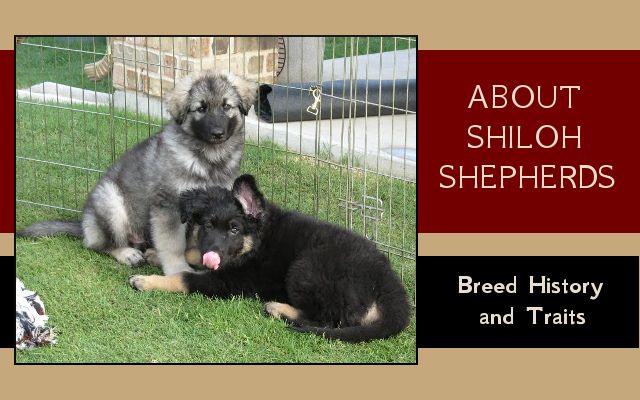
About Shiloh Shepherds - General Breed Information
HISTORY
From the mid-1970’s, Tina Barber of Shiloh Kennels bred oversized German shepherd dogs for personal protection. Her grandmother had bred huge shepherds in Poland, and Tina had fond memories of growing up with the dogs during her own childhood in Germany. However, as the 70’s turned to the 80’s, Tina began running into big problems with hip dysplasia in her beloved GSDs. It was also becoming obvious to her that the very high-drive and high-energy dogs weren’t a good fit for most American families.
Tina decided that she might be able to address these issues by crossing in a different breed of dog and creating her own breed, to be kept firmly under her oversight while it developed. She crossed in a dog that had some Eastern European flock guardian in it (though the breed was never confirmed, the dog used matched the description of a Sarplaninac). Then she acquired a stud who was a crossbred mixture of German shepherd and Malamute. When she added the Malamute cross, she split her dogs off officially from the AKC. The Shiloh Shepherd became its own rare breed in 1991.
Tina Barber was our mentor and friend, and she passed away on Memorial Day, 2011, shortly after Zak and I whelped our first litter of pups. The ISSA club and registry of which we are now a part was created to preserve the essence and character of the Shiloh Shepherd as envisioned by Tina, while taking advantage of new insights into genetics and sustainable breeding to keep these dogs healthy and viable far into the future.
APPEARANCE AND TEMPERAMENT
Shilohs come in a variety of colors, including all shades of sable from grey to golden or even deep reddish brown. They can be saddle-marked (we call it "dual") like a traditional German shepherd, or bi-colored (mostly black but with cream or tan on their legs, chest and sometimes face). We also recognize solid black and solid white or buff dogs.
There are two coat types in the breed: smooth, which is similar to the traditional German shepherd coat but often a little softer, and plush, the long coat. Here at Sparta we are very partial to the smooth-coated dogs. They do very well in the warmer climates, but still can stand up to the winter cold, and the coat is so very easy to care for! We also feel that a big, well-built smooth is a very impressive dog for those who appreciate the beauty of the original German shepherd dog.
For temperament, Shilohs are generally larger, calmer, and have a bit lower drive and energy than most working shepherd dogs. As such they are a bit more “family-friendly”. However, it needs to be stressed that these are still SHEPHERDS! They are large, strong, highly-intelligent and social dogs who want to be with their family. They will require training, and firm ground rules for behavior, to make them fantastic family members.
Within that description, there are a range of energy levels, drives, aptitudes, and personalities within the breed! Be sure to tell your breeder if there is a particular thing you’d really like to do with your puppy. At the Litter Evaluation (done at eight weeks of age), we test for sociability, independence, scenting aptitude, retrieve and prey drive, noise threshold, and even problem-solving ability. If you want a jogging companion, a Therapy dog, an Obedience star, a Service prospect or even a potential Search-and-Rescue dog, the appropriate traits can be assessed to see which pup is the best fit for your intended lifestyle!
SOCIALIZATION
Socialization is not optional for this breed if you want them to turn into great family companions. Puppies should be taken out into the world and given positive experiences almost from the time you first bring them home. The general ground rule is, if you want your dog to react well to a situation as an adult, you need to expose them to it in a positive way when they are a pup--the younger the better. The key early socialization window is between eight and sixteen weeks. If you don’t have time to socialize a dog, then this is not the breed for you.
EARLY TRAINING
As with any large, strong breed, training and ground rules are advised from pretty much day one. As we like to say, it is much easier to get them used to doing what you want when they are only 20 pounds—don’t wait till they weigh 120!
That said, these dogs are lightning-fast learners, especially when you start early. They housebreak in record time and are invariably star pupils at obedience class. It is pretty simple to mold your new pup into a model canine citizen with a bit of consistency, diligence and attention on your part!
GROOMING
Do they shed? Oh, yes they do! If shedding is a deal-breaker, this is not the breed for you.
We’ll be putting up more content about the breed as we develop this new site, but you may also want to check out our ISSA main site at www.shiloh-shepherd.com! There you can find even more breed information including a bit more in-depth write-up on Shiloh Temperament and a comparison page (with photos!) on how a Shiloh is different from the German or King Shepherd breeds. You can also find a complete listing of ISSA breeders, and a page full of planned Upcoming Litters across the world!
Thanks for reading, and remember, if you have more questions, just drop us an email at sparta.shilohs@gmail.com.